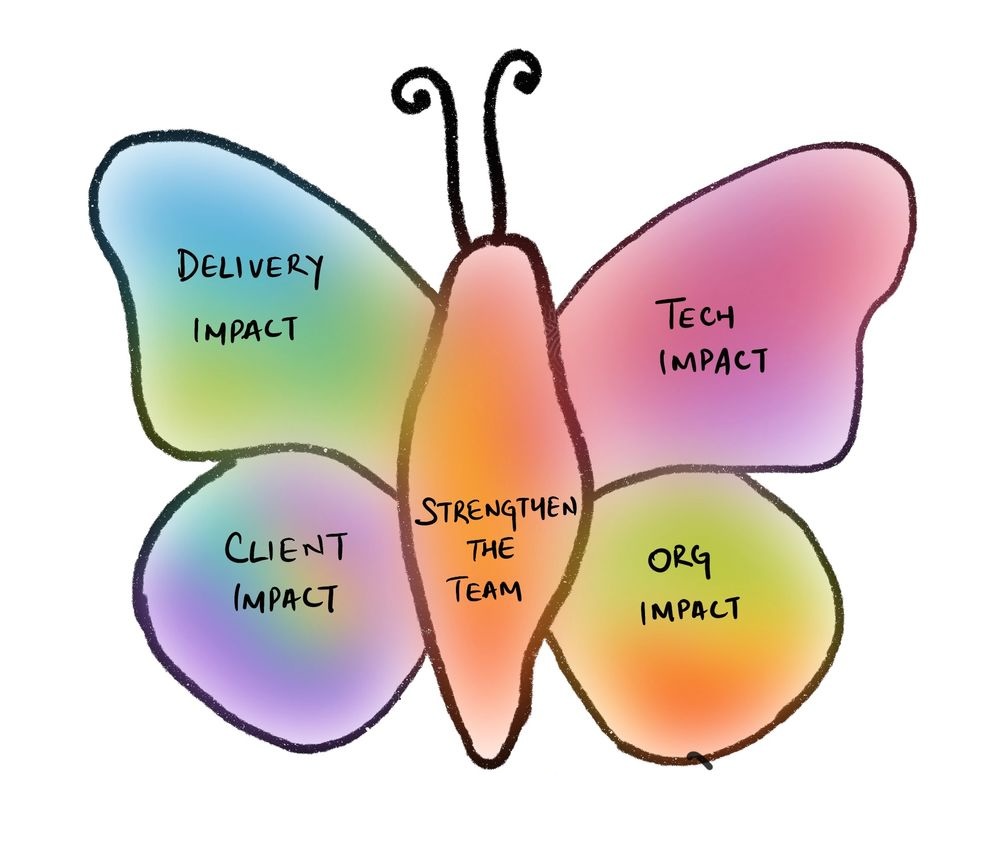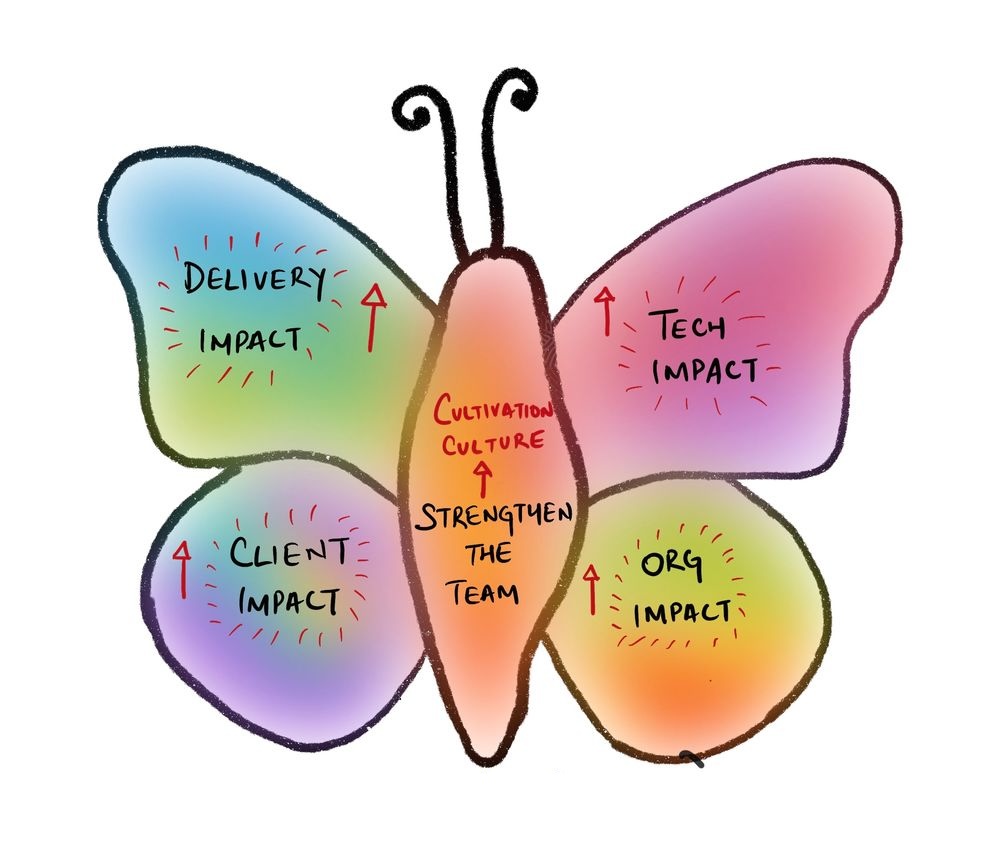The most important thing to do as a Tech Lead

Creating a Culture of Cultivation on your team is the most impactful thing you can do as a Tech Lead. It’s an investment which keeps paying back for you and for all your stakeholders in the long term.
When a team builds a culture of cultivation in the team, everyone benefits – starting from the individual team members to the Tech Leads themselves. The stakeholders benefit from it and so does the larger organization. Let’s take a closer look at how.
In this post, we’ll primarily see this from the lens of the Tech Leads in a team.
Responsibilities of a Tech Lead

As a tech lead it’s useful to look at the responsibilities that you carry on the team using what we call the Butterfly Model of Tech Leadership. We’ve used this model extensively in our Tech Leadership training. The model is based on the representation of a butterfly, with a core body and four wings. On the wings are four impact areas of team and thus the Tech Lead’s for its stakeholders i.e. Delivery Impact, Client Impact, Technology Impact and Organizational Impact.
Technology Impact
As a Tech Lead, it is your responsibility to make the appropriate technology choices and the right technical decisions. This involves things like creating the right architecture, picking appropriate technology tools for the project, designing a proper test strategy, user experience etc. Of course, on an agile/XP team these decisions are made collectively so you get everyone’s inputs and take everyone along in the journey. But ultimately it is your responsibility as a Tech Lead to get the technology right.
Delivery Impact
Along with helping to create the right technical infrastructure for the product, you also keep a keen eye on delivery commitments. It’s your responsibility to understand the business context, organizational context and constraints to co-create a delivery plan along with the stakeholders. But a good plan is worth nothing if it doesn’t get executed well. So creating the conditions in which your team can achieve its delivery targets becomes an important responsibility that you hold as a Tech Lead. On one hand, you have to keep reflecting and adapting the plan according to yesterday’s weather and changing business context; and on the other, you need to keep enabling the team to get stuff done smoother and faster.
Client Impact or Organizational Impact
Beyond delivering great software, and keeping your delivery promises, as a Tech Lead you also look to create impact for the broader business and IT organization in wider ways. Examples of this are helping them make the right choices on their priorities or helping them spot and execute new business opportunities. Often stakeholders expect teams and thus you as a Tech Lead, to help them in other ways such as:
- Help create better collaboration between different parts of the organization.
- Help make cultural shifts in their organization leading to better development practices
- Contribution to hiring new employees
- Sharing your knowledge within the community
- Talking at conferences
- Contributing to open source software etc.
As a Tech Lead, you have the responsibility to make these kinds of contributions yourself. Additionally, you’re in a position to also influence your team members to engage with these organizational activities and create high impact as a team.
Now, at the centre of the butterfly model is the Tech Lead’s responsibilities towards the team.
Strengthening the Team
As a Tech Lead, there are two broad things that you can do to strengthen your team.
First is to create a culture of cultivation i.e. to create the conditions under which every team member can do their best and can continuously grow on the team. Second is to create conditions where team members can collaborate effectively with each other.
Cultivation Culture on a team equates to the team members exchanging feedback to help each other grow frequently. It involves people on the team learning from and with each other. It also involves the team and the leadership in particular being good at spotting and nurturing potential in their teams. And finally the team places high value on cultivation, they appreciate it when they see others engaging in cultivation activities.
When you focus on this one thing, you create an impetus for the other four areas of impact, consequently multiplying your impact as a Tech Lead. The correlations are quite straightforward with the other areas of impact. Let’s have a look:

On Technical Impact: The quality of technical decisions made in a team, will improve as the team members learn new knowledge & skills. Team members and you will be able to make better judgments if the team exchanges ideas & inputs freely & frequently.
On Delivery Impact: When people on the team constantly help each other, re-affirm productive behaviors and correct negative ones by sharing feedback with each other, it improves their productivity. When they are encouraged to tap into their strengths and pick up more responsibilities that align with their aspirations, they can get more done for the team. A team with such an environment, is also likely to create a stronger affinity for the team members to stay on the team longer. This creates a huge payoff for the team in terms of increased confidence to tackle difficult problems and to meet their delivery plans.
On Client Impact: The impact on the wider ecosystem increases for a team once the leaders on the team feel confident that they can deliver on their promises while keeping quality high. Tech Leads can spend more energy engaging in strategic conversations about the client/business ecosystem, once they are confident that the team can execute the day to day tasks well by themselves. Investing in cultivating your team members helps strengthen delivery on the team which in turn creates bandwidth for you and your team to create value beyond just delivering software.
On Organizational Impact: Once the team is confident of its ability to get stuff done predictably, consistently & with high quality, then they are freed up to be proactive in contributing to the organization beyond their project work. When you focus on team members’ learning & growth, it raises the quality of work on the team. And that eventually allows you and the team to contribute their energies and skills to create lasting impact and value for the organization.
Acknowledgements
- A version of this article was originally published by Chirag and Chitra on ourculturecafe
- Cover image: Photo by Hannah Busing on Unsplash
- References: Dan Abel’s article which inspired our Butterfly model
- Illustrations of the Butterfly model: by Chitra
Subscribe to the Next Iteration Newsletter to get members only content and insights directly in your inbox!
